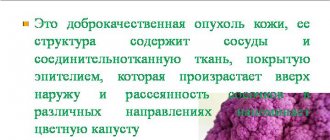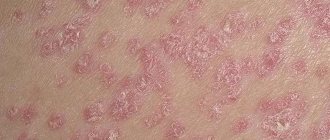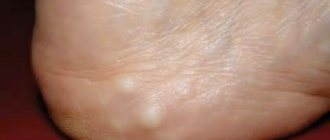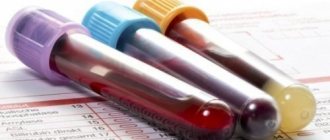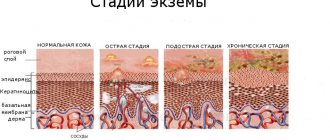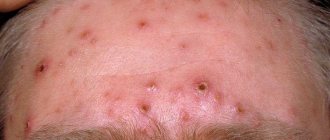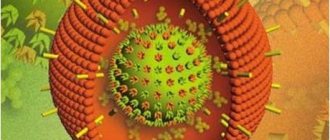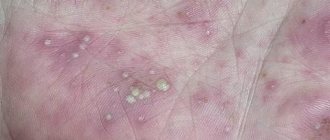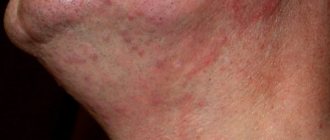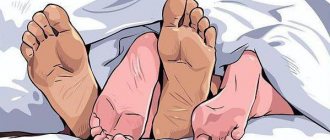What is erythema
Erythema is redness of the skin, which is caused by various factors. This may be physical effects on the skin, increased ambient temperature, contact with heated surfaces or hot water. In these cases, redness of the skin is a physiological reaction of the body that occurs without a trace and passes quite quickly. Sometimes erythema appears without obvious reasons, in such cases it signals an inflammatory process or pathological changes. In general, this term is used to refer to three main conditions:
- changes in skin color caused by dilation of blood vessels;
- signs of some dermatological diseases;
- independent illness.
In most cases, this condition is diagnosed in children between five and twelve years of age and young adults between twenty and thirty years of age. Skin redness can also develop in patients of other age groups.
Erythema as . If physiological redness occurs as a result of external factors - increased body temperature or ambient air, physical activity - no treatment is required; after a short period of time, the skin acquires a normal shade. If the capillaries fill with blood as a result of insect bites, sunburn, or skin injuries, the manifestations of erythema disappear as soon as the provoking factor disappears. Usually in these cases no treatment is needed.
A rush of blood to the skin may indicate pathological processes occurring in the body. This is inflammation, the penetration of viruses and bacteria, fungal microorganisms into the body. This could be staphylococcus and other bacterial infections. When they enter the upper layers of the epithelium, they cause dermatological diseases. The affected areas turn red, blood actively flows to them, and swelling may develop. Typically, redness appears in the form of single or multiple spots, which can merge with each other. The color of the skin varies from pink to bright red. In some cases, a rash appears in the affected areas - blisters, roseola, papules, plaques, pustules. Possible thickening of the skin and deformation of blood vessels.
The course and prognosis of the disease depend on the causes that caused it. Depending on the causative agent of the pathological process, a treatment strategy is selected.
According to the ICD-10 classification, most types of this disease are encrypted with codes L50-L54. These are the following forms of the disease:
- 51 – exudative, can be local or total, appears against the background of autoimmune diseases, allergic manifestations;
- 52 – nodular, can develop against the background of various infections;
- 53 – ring-shaped, with it round spots are formed on the body, which can merge with each other; usually manifests itself after an overdose of pharmacological drugs or poisoning.
There are types of erythema that do not belong to this group. This is a toxic form that appears in infants. Other categories also include childhood infectious and burn erythema.
Etiology of the disease
For a long time, the causes of erythema infectiosum were unknown. Currently, infection with parvovirus B19 is considered the main etiological factor. This DNA-containing virus was identified in 1974 from human blood serum and received its name from the number and series of the plasma sample being studied. Since July 2013, it has been called Primate erythroparvovirus 1.
The infection is transmitted from an infected person by airborne droplets and vertically (transplacentally from mother to fetus). There is also a risk of infection from transfusions of blood and its components, as well as from organ transplants from a donor infected with parvovirus. But the likelihood of this is low, because the pathogen is not prone to long-term persistence in the human body.
The main target of the virus is erythroid progenitor cells in the bone marrow. In the fetus, cord blood erythroblasts and the fetal liver, the main extramedullary hematopoietic organs, are also affected. This can cause clinically significant disturbances in erythropoiesis, although most often the peripheral blood pattern remains virtually unchanged.
Why a rash appears in certain areas of the body and other symptoms of erythema infectiosum is still not reliably known. The most striking manifestations of the disease are observed in patients with a tendency to hypersensitivity. Often a characteristic rash appears against the background of other diseases: rheumatism, tularemia, tuberculosis. Taking sulfa drugs is also considered a factor that contributes to a more severe and complicated course of erythema infectiosum. Immunodeficiencies of various etiologies operate in the same way.
Video: Erythema infectiosum
Forms of erythema
This disease has many types and forms. They differ in symptoms, treatment strategy, and causes. They can be divided into two main groups: infectious and non-infectious. The latter include redness that occurs in response to the action of an irritating agent or allergen. Infectious diseases are caused by exposure to pathogenic organisms. Usually accompanied by signs of intoxication and fever, however, with chronic infections these symptoms may be absent.
- Nodular - can be caused by viruses. With this disease, the lesions resemble nodes, they are dense to the touch and cause discomfort to the patient. In most cases, they are located on the inner thigh or shins. Inflammation is localized in the subcutaneous tissue or in all layers of the skin.
- Persistent, elevated - initially looks like tubercles, which gradually merge into lesions. Over time, they darken and become dense to the touch. Lesions may resemble irregular plaques that become yellowish and flaky. The rash may be painful and cause a burning sensation. They don't itch. Less commonly, ulcers or bruises appear at the site of plaques.
- Ring-shaped - this form is characterized by the appearance of round spots that can merge with each other. appear in the central part of the spots or peeling begins. Usually this form becomes chronic. When immunity is weakened, relapses of the disease may occur.
- Solar – sometimes called sunburn. At first, the affected areas turn red, then itching occurs, and blisters filled with clear liquid form. They can open spontaneously. Gradually, peeling begins on the affected areas. Ultraviolet is considered a subspecies of solar radiation. The manifestations and prognosis are similar, but this erythema has a slightly different cause. It develops as a result of ultraviolet radiation in solariums or during physiotherapy sessions. It is treated mainly symptomatically.
- Viral – develops as a result of penetration of pathogenic microflora into the body. Usually the patient's condition worsens, and isolated foci of inflammation merge into large spots. The disease may be accompanied by fever or chills, pain in the joints and muscles. Signs of intoxication of the body often appear, and pain in the liver area may occur. The patient loses his appetite and becomes nauseous.
- Migratory - often becomes chronic. Initially it looks like a small spot, which then quickly grows. It does not peel off or become covered with ulcers. It may go away on its own or lead to complications and damage to the nervous system.
- Exudative is characterized by rashes on the skin, the appearance of lesions on the mucous membranes. It can be acute or become chronic. A rash, bright red spots, and blisters may form on the affected areas. They should not be scratched: this can lead to infection, which complicates the course of the disease.
- Polyform - affects the skin and mucous membranes. A rather dangerous form in which the rash has the form of blisters. They are filled with fluid - hemorrhagic, serous. The affected areas itch and touching them causes pain. At the same time, patients exhibit flu-like symptoms: muscle pain, weakness, fever to subfebrile levels. Conjunctivitis and other eye diseases may develop. In severe cases of such eczema, death cannot be ruled out. Most often this disease is diagnosed in young men.
- Palmar is a form of the disease in which the affected areas are limited to the palms of the hands. They show symmetrical redness.
- Toxic – develops in infants in the first month of life. It is believed that this pathological condition manifests itself due to adaptation of the body. The rash affects the back, abdomen, buttocks, and flexor surfaces. Blisters with serous contents may appear on the skin. Does not require treatment and goes away as the child grows older.
- Fixed - appears after the introduction of certain medications into the body: sleeping pills, contraceptives, antibiotics. It usually does not require treatment and goes away on its own immediately after stopping the medication.
- Persistent curly - considered a genetic disease in which one or more reddish spots appear on the body. In the center, such spots can peel off, and their size reaches ten centimeters.
- Dyschromic is a type of lichen planus that is quite rare. It is characterized by gray rashes that can go away on their own. There is no specific treatment for this type of erythema.
- Skin erythema of Chamera - redness appears in the first day after infection of the body, then becomes more pronounced. The rash is localized on the cheeks and may spread to the chin or nose, resembling the wings of a butterfly. The temperature rises to low-grade levels, and sometimes the joints may become slightly swollen. The duration of the disease is up to two weeks, treatment is predominantly symptomatic.
- Beeta - this centrifugal erythema is a type of lupus. A rare disease that does not lead to a deterioration in the patient’s well-being. It is characterized by reddish rashes that are localized on the bridge of the nose and cheeks. It is an autoimmune disease that is treated with the same medications as lupus. These are antimalarial therapy, antioxidants, vitamin complexes.
- Daria. Characteristic signs of the disease are nodules, in the central part of which there are depressions. Such rashes look like rings; they appear on the body; there is practically no rash on the face.
- Cold is the body’s reaction to hypothermia. Usually localized on open areas of the body: cheeks, palms. Reddish rashes appear on them, which may peel off. Sometimes the rash is accompanied by discomfort, burning, and itching. It is believed that this type of erythema is provoked by certain types of proteins, which produce histamine when cooled. Treated symptomatically.
- Thermal - occurs as a result of exposure to infrared rays. After eliminating the source of radiation, it goes away without treatment.
- Scarlet fever - resembles scarlet fever in appearance. It always begins acutely, with a sharp rise in temperature and deterioration in the patient’s well-being. A bright scarlet rash appears on the skin. This form is caused by bacteria. Later, the lesions become severely peeling.
- Radiation – occurs as a result of irradiation. The early form is characterized by slight swelling and redness and goes away quickly. The true one appears later, after a few days. The affected areas itch, patients experience pain and swelling.
- Gammel - most often appears on the chest, neck or face. It is characterized by sinuous rashes. They form stripes and patterns on the skin. This is a tumor marker that indicates the development of a malignant neoplasm in the body.
- Bloom is a congenital disease for which there is no cure yet. It is an autoimmune disease, manifested by rashes on the face that resemble the rash of lupus. Typically, patients with this erythema have a specific skull shape and dwarf stature.
READ ALSO: Wen on the face: photos, reasons, how to get rid of it quickly
Further symptoms
Symptoms of pathology vary depending on what form of the disease affects the person. The signs are the same in both adults and children. It is worth noting that it is in children that erythema multiforme is more severe. Therefore, it is important to immediately take the child to a medical facility at the first signs of progression of the disease.
Symptoms of exudative erythema multiforme
Symptoms:
- headache;
- malaise;
- pain in the throat, joints;
- rashes form on the skin. They are also observed on the mucous membrane of the oral cavity, on the border of the lips and on the genitals. It is worth noting that rashes can sometimes be localized in only one place, for example, only in the oral cavity or only on the genitals;
- symptoms of intoxication disappear 2–5 days after the appearance of the rash, but the temperature can last up to 3 weeks;
Swelling, limited spots or flat papules appear on the skin or on the oral mucosa. They have a pink-reddish color. These formations are increasing very quickly. The maximum size is 3 cm. The central part of the rash is slightly sunken and has a bluish tint. Also, pathological vesicles may form in the center, containing exudate. The patient notes that the rash is itchy. But more often there is a burning sensation.
Exudative erythema multiforme on the oral mucosa
The clinical picture of exudative erythema on the oral mucosa is more monotonous. But this form of pathology is especially difficult, since the subjective symptoms are very pronounced. The favorite localization of rashes is the palate, cheeks, vestibule of the mouth, lips.
We suggest you read: Hands itch and white bumps appear
It is worth noting that the disease begins acutely and suddenly. First, edematous and diffuse erythema forms on the oral mucosa, but after a few days blisters form on it. After a few days, they open and erosive areas form. They can be so large that they cover the entire oral mucosa, as well as the lips.
Thick bloody crusts often form on the lips, which prevent the mouth from fully opening. It is worth noting that in some people, erosions can cover the entire oral cavity, while in others, on the contrary, only isolated erythematous-bullous rashes appear.
With extensive damage to the oral mucosa, the following symptoms are noted:
- severe pain;
- Exudate is separated from the surface of erosions in large quantities;
- increased salivation;
- it is impossible to open the mouth completely;
- speech is difficult;
- It is impossible to take even liquid food.
With this form, a rash appears, which is visually very similar to the rashes in the infectious-allergic form. Foci can be both fixed and widespread. If widespread rashes occur, the oral mucosa is most often affected.
Fixed rashes, as a rule, appear in the same places where they appeared before, but this does not mean at all that they cannot appear in other areas. The oral cavity is most often affected, since it is in this area that sensitivity to drugs is quite high. It is worth noting that sometimes blisters can appear on unchanged skin or mucous membranes.
This form of pathology is not characterized by seasonality. It is not preceded by any symptoms. Rarely, body temperature may rise slightly.
It is assumed that exudative erythema in 70% of patients is provoked by decreased immunity against the background of protracted bacterial infections. Inflammation of the maxillary sinus, inflammatory process in the ear, inflammatory process occurring in the palatine or pharyngeal tonsils, and non-specific infectious kidney disease increase the body's susceptibility to pathogens. The disease can also be localized in your oral cavity.
Another 30% of people develop a toxic-allergic form of the disease. The rash occurs after vaccination, the inclusion of serums, and taking medications derived from barbituric acid.
Exudative erythema is most often recorded in a child aged 5-7 years and is considered the result of allergic interactions with provoking agents (medicines, household chemicals, food products).
The appearance of polymorphic rashes is traditionally preceded by a sudden complication of general health. Children experience fever, joint pain and headaches. The eruptive components shock the oral mucosa at the same time. All the variety of eruptive components can be analyzed in a photo of erythema in a child.
Clinical signs of the disease in children and adults are similar. The disease is especially difficult to resolve when the mucous membranes of the oral cavity are affected. The child refuses to eat. This further exhausts the already exhausted child and reduces the body’s defenses. Exudative erythema in young children has a recurrent appearance and can appear from time to time throughout life, but in some cases the disease suddenly disappears by the age of 17.
The disease is characterized by an acute onset and the appearance of flu-like symptoms:
- increased body temperature;
- sore throat and headache;
- joint pain;
- sore throat, coughing;
- general painful condition, impotence;
- loss of appetite;
- muscle pain, body aches;
- enlarged lymph nodes.
The area of erosions can grow, they are predisposed to merge with each other, as a result of which the sources are spread over a significant area of the mucosal plane, causing severe pain, which is even more intensified when eating and talking. In a child, this leads to a refusal to eat and rapid dehydration of the body with the formation of a serious condition.
Then, in the scarlet border of the lips, erosions become covered with brownish fibrinous, sometimes brown, bloody crusts, and in the oral cavity - plaque. Exudative erythema multiforme in the oral cavity is accompanied, in addition to painfulness, by increased salivation and inflammation of the gums.
1–2 days after the onset of the disease, the skin is affected by lesions the size of grains. The infection progresses, the components of the rash reach 2–3 cm in diameter. The papules rise slightly above the surface of the integument and are scarlet in color. In the middle there is cyanosis.
Polymorphic erythema is characterized by the appearance of a polymorphic rash (papules, vesicles, bullae, hemorrhages). The rash consists of clearly visible pink or scarlet papules, accompanied by swelling. They are prone to rapid growth, their diameter reaching in some cases up to 3 cm.
As the disease develops, the center of the papules begins to sink, acquiring a blue color. In their area, blisters with exudate from blood or a clear protein liquid secreted by the serous membranes appear. Similar formations begin to appear on the healthy plane of the epidermis. The rash is characterized by a burning sensation or intense itching.
After 1-2 days, and in some cases on 4-6 days from the onset of the first signs and within 1.5-2 weeks, rashes appear on the skin again, after which the patient’s general situation improves slightly.
The rash has the type of small (1-2 millimeters) spots of a visually red color and a rounded shape, slightly rising above the skin level due to an edematous ridge. They rapidly increase in volume and reach a diameter of 20 millimeters.
At the same time, a nodular-papular rash of similar volumes and with precise contours also appears with the spots. The rashes do not tend to merge with each other and are characterized by a burning sensation.
After 1-2 days, spots and papules in the central part acquire a brown or dull violet-bluish tone. Between these 2 areas there is a dull, elevated corolla (a sign of a cockade). Later, a rash with watery contents forms in the center of the papule or spot, and then the walls dry out.
The clinical picture allows the dermatologist to make a preliminary diagnosis. In a more complex situation, additional examination is necessary to determine the type of disease and select the most effective treatment.
Exudative erythema multiforme (photos of the early stage will allow timely contact with a dermatologist) is accompanied by the following clinical symptoms:
- general malaise, weakness in the body;
- polymorphic rashes;
- burning and severe itching at the site of blistering;
- headache;
- low-grade fever;
- discomfort in the throat;
- increased fatigue;
- joint pain.
We suggest you familiarize yourself with Wormwood for fungus in the body
Severe damage to the mucous membranes is characterized by the following clinical symptoms:
- the patient cannot open his mouth completely;
- a sharp pain syndrome appears;
- difficult to talk;
- it is painful for a person to eat food even in liquid form;
- salivation increases;
- A large amount of exudate is released from the papules.
Pathological processes are accompanied by characteristic rashes on the body, which change and spread as the disease progresses. They affect the mucous membrane of the mouth, genitals, and appear on the lips. Symptoms of intoxication disappear after the appearance of the rash, but the temperature in some situations persists for another 3 weeks.
Red spots or papules form on the body, which quickly increase, reaching 3 cm. They are accompanied by itching and burning. The central part of the papule is sunken and also has a blue tint. Sometimes bubbles with exudate inside form in the center of the rash.
Causes of the disease
Redness often occurs as a result of intense friction of the skin and exposure to sunlight. Another reason is chemical burns. Erythema may also appear after physical therapy using electric current. Often the cause of the disease is allergies, various types of dermatitis, impaired blood supply to the skin, and infectious diseases.
Depending on the form in which erythema manifests itself, the reasons for the development of this condition may be as follows.
- Erythema migrans in most cases manifests itself after tick bites.
- Ring-shaped is provoked by poisoning and intoxication of the body. Sometimes the cause of this disease is an allergy, an infectious disease, or a malignant tumor.
- Erythema nodosum can be caused by allergic reactions of the body, general intoxication, to which sometimes a virus is added. In this case, the patient’s well-being deteriorates significantly.
- The cause of solar erythema is too intense or prolonged exposure to ultraviolet rays on the skin.
- Viral erythema is the result of penetration of bacteria, viruses, and pathogenic microflora into the epithelium or deeper layers.
- Exudative eczema is provoked by staphylococci and streptococci. The cause of its appearance may be the herpes virus.
- After taking certain categories of medications, a fixed form of the disease may appear.
- Palmar erythema usually develops against the background of liver failure, rheumatoid arthritis, and diseases of the circulatory system. Sometimes it is caused by pregnancy. It may be congenital - in this case it does not require treatment.
- The reasons for the appearance of persistent erythema are not precisely known; presumably, this is one of the manifestations of allergies or a subtype of granuloma.
READ ALSO: What bedbug bites look like: detailed description and photographs
Treatment and prognosis
If erythema infectiosum is detected, the patient is prescribed home bed rest.
Inpatient therapy applies only to children. An adult must be hospitalized in case of a severe form of the virus and the development of complications. Pregnant women infected with the “fifth disease” are placed in a hospital for safekeeping. Treatment is carried out under the supervision of doctors and ultrasound monitoring of the fetus.
Pregnant women who do not seek treatment in a timely manner are at risk of losing the fetus.
Elimination of infection is carried out through medicinal effects on the symptoms of the disease. Medicines from popular groups are prescribed:
- antihistamines;
- antipyretics;
- antibiotics (if microbes are present);
- antispasmodics.
In severe cases, broad-spectrum steroid hormones are used.
The consequences of skin rashes can be eliminated with external means on the recommendation of a dermatologist. During illness, it is recommended to drink plenty of water and avoid sunlight. The prognosis for identifying erythema infectiosum is positive. Before the first rash appears, the patient is isolated from contact with healthy people. Once spots appear, the virus is no longer dangerous. With the right approach, the “fifth disease” is easily treated.
Symptoms
Erythematous rashes can be localized on the extremities, on the back, head, inguinal and flexor folds. The manifestations of this disease are varied, so it is almost impossible to identify common symptoms.
With acute nodular, viral, erythema multiforme, the following symptoms usually appear:
- weakness;
- elevated temperature;
- the patient may have a disturbed appetite and feel sick;
- there may be chills;
- sometimes joint pain occurs;
- Lymph nodes may enlarge - they become pronounced, and sometimes patients experience pain when palpating them.
In acute and severe cases of the disease, symptoms of intoxication appear.
In almost all forms of erythema, reddish or pink spots appear on the skin. Later, depending on the type of disease, they merge into common lesions. In areas where the pathological process develops, ulcers can form, sometimes the skin begins to peel, and the color of the skin changes. capillaries become visible .
Erythema nodosum is characterized by the following symptoms that do not appear in other forms:
- nodes that are located symmetrically - the skin above them first turns red, later acquires a bluish tint, and then turns yellow, sometimes with green;
- in the chronic course of the disease, the nodes are less pronounced, but periodically the erythema may worsen, causing some discomfort;
- Sometimes joint syndrome develops - large joints become painful, swelling appears on the skin over them, and it becomes hot.
Fixed erythema is characterized by the appearance of dark: purple, blue spots. They are usually located on the surface of the skin above large joints - in the groin area, under the knees and on the elbows, in the armpits. In the future, they can turn into blisters, which gradually open.
Infectious
https://www.youtube.com/watch?v=tzP9CpUrzP0
Erythema infectiosum in children is caused by the airborne paravirus B19. Children are at risk. The disease develops like a common acute respiratory infection. Viral erythema exhibits similar symptoms:
- Runny nose;
- Sneezing;
- Fever.
Rashes on a child’s skin appear 3–5 days after the first signs of ARVI. Outwardly, these are small red spots on the cheeks. As the disease progresses, the rash appears on the legs, arms, forearms, knees and neck.
The round patch of spots grows gradually, resembling lace woven on the skin. They are usually a deep red color, but turn pink over time. As the symptoms weaken, the spots also disappear, this happens within 7 days.
Erythema infectiosum in children practically does not appear after treatment. It may periodically remind itself after exposure to direct sunlight or when exposed to high temperatures. The spots appear for a while and go away on their own.
Diagnostics
Skin erythema can be diagnosed based on visual examination. It is performed by a dermatologist. Some forms of the disease resemble eczema, urticaria and other diseases, so differential diagnosis may require consultation with a therapist or rheumatologist. A consultation with a pulmonologist is also prescribed if the patient is diagnosed with sarcoidosis, and a phthisiatrician for tuberculosis. An obligatory part of the diagnosis is fluorography or radiography.
Additionally, clinical studies are carried out: general analysis of urine and blood, advanced blood tests. They allow you to identify inflammatory processes in the body and diagnose autoimmune diseases or tumors.
The patient may be prescribed allergy tests if an allergy is suspected. Another diagnostic method is scraping the affected areas and examining the contents of blisters or vesicles.
Additionally, the following studies are carried out:
- rheumatic tests - if erythema nodosum is suspected;
- culture from the nasopharynx - allows you to detect pathogenic microflora;
- bacteriological culture of stool;
- rheovasography of the lower extremities - this study allows you to determine the degree of patency and assess the condition of the blood vessels ;
- pharyngoscopy and rhinoscopy to determine the presence of related infections.
Forecast
The prognosis for cure is positive: the erythema goes away and rarely returns, since lifelong immunity is acquired.
The chronic form of the disease is characterized by relapses when exposed to a pathological or physiological nature, but will not cause serious harm to the child’s health. An examination is mandatory if reddened lesions appear on the skin. Erythema itself is not dangerous, but the diseases that cause it are - oncology or tuberculosis.
Young children often develop various rashes on their skin. This may be due to an allergy or infection. If the rash is caused by pathogenic microorganisms, then the child’s body temperature rises and his throat begins to hurt. Among the types of skin diseases in children is erythema infectiosum.
Treatment of different forms of erythema
If a patient is diagnosed with acute erythema, treatment should be comprehensive. First of all, it is necessary to eliminate the factors that provoked this disease:
- if infection with pathogenic microflora is detected, antibacterial therapy is carried out;
- for chronic diseases or conditions that provoke the appearance of erythema, a treatment strategy is selected that allows you to get rid of the disease or achieve stable remission;
- if erythema is an allergic reaction of the body, it is necessary to eliminate contact with the allergen;
- If the body reacts to medications in such a way, the treatment regimen is changed.
The next stage is drug therapy. Some types of disease do not require treatment, others are treated with antibacterial therapy and anti-inflammatory drugs. Facial erythema with the appearance of ulcers or inflamed areas is treated comprehensively: by taking the medication orally (in the form of tablets or by injection), as well as bandages with anti-inflammatory, disinfecting, and wound-healing ointments.
READ ALSO: Rash, pustules on the palms and soles; Benefits and harms for the human body
When treating this disease, the following groups of medications are used:
- angioprotectors;
- antibiotics;
- corticosteroids;
- antihistamines;
- disaggregants;
- drugs that strengthen the walls of peripheral blood vessels;
- adaptogens.
General recommendations for the treatment of this pathology boil down to following a diet and avoiding foods that provoke allergic reactions. Patients should follow a sleep schedule; if their health worsens, bed rest is indicated. If your health allows, you can perform gentle physical exercises. When the temperature rises, patients are prescribed antipyretic drugs. A specialist may recommend analgesics if the pain syndrome is pronounced.
You can apply bandages with dimexide topically. If there are no strong foci of inflammation, dry heating gives a good result: with heated salt or cereal, or a boiled egg. If foci of the disease appear on the mucous membrane, they are treated with boric acid and a manganese solution.
When treating fixed erythema, it is imperative to complete the full course. For this form, it is advisable to avoid the use of sulfonamides. It has been established that these substances can provoke a relapse of the disease in the future, and rashes appear in the same places as at the first manifestation of the disease.
Self-medication is strictly prohibited. The use of folk remedies or incorrectly chosen therapy can significantly worsen the patient’s condition and provoke the transition of erythema to a chronic form. In addition, they cause the development of complications - most often aplastic cry. In this condition, red blood cells die en masse in the bone marrow. This leads to the development of anemia. Even with the right treatment strategy, this condition can occur in patients with blood disorders or reduced immunity.
For some forms of the disease, physical therapy is indicated. These are phonophoresis with hydrocortisone, ultraviolet irradiation, laser and magnetic therapy. Such procedures speed up recovery and relieve inflammation, especially if deeper tissues are affected: joints, subcutaneous tissue, muscles.
Exudative erythema multiforme in children
In children, the pathology is diagnosed at an early age – 2–5 years.
In most cases, this is a consequence of an allergic reaction to household chemicals, cigarette smoke, food or medications. When studying the anamnesis, they check whether close relatives have allergies. More often, delayed reactions are observed (not immediately after contact with a harmful substance), which makes it difficult to determine the irritant. The disease can occur with seasonal relapses or year-round.
Before the rash appears, the temperature rises sharply to 37–38.5 ° C, headaches, joint and muscle pain are felt. Papules and blisters immediately appear on the limbs, forearms and in the mouth area. Pink spots on the body increase in size and take on a bluish tint.
If the mucous membrane is severely damaged, the child refuses to eat due to severe pain. Fasting leads to even greater exhaustion of the body. An aggravating factor is the presence of caries and decayed teeth in the mouth.
The disease can remain for life, periodically reminding itself of relapses. But sometimes it disappears spontaneously by the age of 14–16 years.
In 5% of patients, the rash is localized exclusively on the mucous membranes of the oral cavity:
- on the lips;
- in the sky;
- inner surface of the cheeks;
- in the throat.
At first there is slight redness, but after 1–2 days blisters form. After 2–3 days they burst, leaving painful erosions. The elements tend to merge and spread throughout the entire oral cavity. They are covered with a gray or yellow coating. If you try to remove it, the wounds begin to bleed and heal slowly.
Extensive erythema causes a lot of inconvenience, preventing a person from talking or even eating liquid food. Bloody crusts and cracks appear on the lips, preventing the mouth from opening. The infectious process complicates dental hygiene, salivation increases, and gingivitis (inflammation of the gums) develops.
However, the rash may consist of only a few small lesions. The resolution process on the mucous membranes takes longer than on the body - on average 1–2 months.
To prevent the body from becoming depleted due to the inability to eat properly, the pain syndrome is first relieved. Before eating, the rashes are treated with a 0.5% solution of novocaine, Lidochlor gel, or an anesthetic emulsion with peach oil.
To disinfect the mouth and relieve swelling, rinsing with chamomile decoction, treating rashes with sea buckthorn oil, a weak solution of hydrogen peroxide or Rotokan are prescribed.
It is important to note that the term “exudative erythema” is also used when necessary to designate clinically similar symptoms. The photo above shows an example of the external symptoms of this phenomenon.
Prevention
There are no clearly effective measures that will completely protect against the occurrence of such pathology. Since different forms of the disease are provoked by various factors, it is impossible to exclude them all. However, you can reduce the risk of erythema by strengthening the body's defenses. In general, prevention of this disease comes down to strengthening the immune system, and in the presence of allergic reactions, minimizing contact with allergens.
- It is necessary to follow a sleep and rest schedule and avoid stress. One of the indirect causes that causes dermatological diseases is chronic stress.
- You should lead a moderately active lifestyle. Regular jogging or physical exercise, cardio exercise is a good way to strengthen the walls of blood vessels. Such measures reduce the risk of rashes.
- A balanced diet with a predominance of protein and plant foods. It is necessary to minimize the consumption of fatty or spicy foods, the amount of sugar, and products with chemical dyes or preservatives. They can provoke allergic reactions.
- If your immune system is weakened or after an illness, you should take courses of multivitamins and mineral preparations. They should be selected by a therapist.
- Staying in the open sun should be limited to morning and evening hours. Before sunbathing, be sure to use sunscreen cosmetics.
- To reduce the risk of erythema, you should give up bad habits. Smoking and regular consumption of alcoholic beverages often lead to the appearance of erythema.
Prognosis for recovery
Erythema infectiosum usually resolves within 2-3 weeks. With proper treatment, the prognosis is favorable. There are no serious complications, no scars remain after the rash.
A common form of the disease - sudden exanthema - affects 30% of all children and is accompanied by severe symptoms, but does not pose a health hazard with adequate treatment (see also:). It goes away within a week without complications. After recovery, lifelong immunity to sudden exanthema is formed.
Adverse consequences for children can occur due to blood disorders, anemia - an infectious disease will aggravate the health condition. It will also negatively affect a child with immunodeficiency. There is a high risk that erythema will progress to a chronic stage.
Exudative erythema multiforme is also dangerous. It is caused by serious diseases and in itself is fraught with serious consequences. In particularly advanced, complex cases, exudative erythema multiforme even leads to death.
